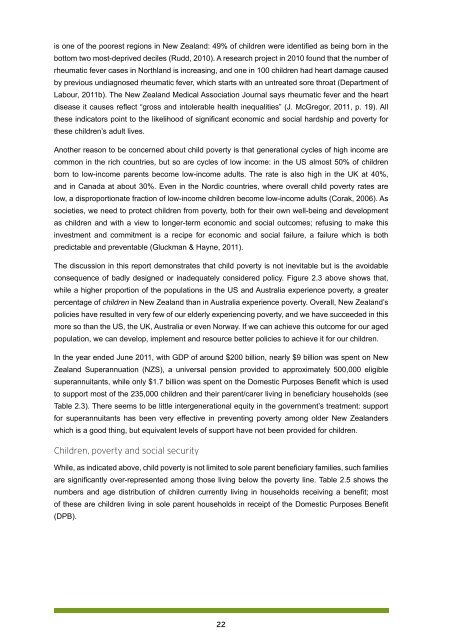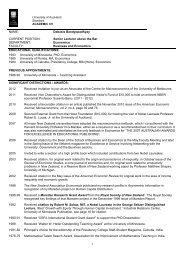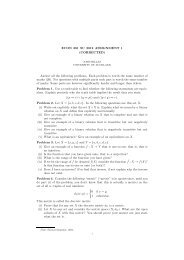Left Further Behind - Child Poverty Action Group
Left Further Behind - Child Poverty Action Group
Left Further Behind - Child Poverty Action Group
Create successful ePaper yourself
Turn your PDF publications into a flip-book with our unique Google optimized e-Paper software.
is one of the poorest regions in New Zealand: 49% of children were identified as being born in the<br />
bottom two most-deprived deciles (Rudd, 2010). A research project in 2010 found that the number of<br />
rheumatic fever cases in Northland is increasing, and one in 100 children had heart damage caused<br />
by previous undiagnosed rheumatic fever, which starts with an untreated sore throat (Department of<br />
Labour, 2011b). The New Zealand Medical Association Journal says rheumatic fever and the heart<br />
disease it causes reflect “gross and intolerable health inequalities” (J. McGregor, 2011, p. 19). All<br />
these indicators point to the likelihood of significant economic and social hardship and poverty for<br />
these children’s adult lives.<br />
Another reason to be concerned about child poverty is that generational cycles of high income are<br />
common in the rich countries, but so are cycles of low income: in the US almost 50% of children<br />
born to low-income parents become low-income adults. The rate is also high in the UK at 40%,<br />
and in Canada at about 30%. Even in the Nordic countries, where overall child poverty rates are<br />
low, a disproportionate fraction of low-income children become low-income adults (Corak, 2006). As<br />
societies, we need to protect children from poverty, both for their own well-being and development<br />
as children and with a view to longer-term economic and social outcomes; refusing to make this<br />
investment and commitment is a recipe for economic and social failure, a failure which is both<br />
predictable and preventable (Gluckman & Hayne, 2011).<br />
The discussion in this report demonstrates that child poverty is not inevitable but is the avoidable<br />
consequence of badly designed or inadequately considered policy. Figure 2.3 above shows that,<br />
while a higher proportion of the populations in the US and Australia experience poverty, a greater<br />
percentage of children in New Zealand than in Australia experience poverty. Overall, New Zealand’s<br />
policies have resulted in very few of our elderly experiencing poverty, and we have succeeded in this<br />
more so than the US, the UK, Australia or even Norway. If we can achieve this outcome for our aged<br />
population, we can develop, implement and resource better policies to achieve it for our children.<br />
In the year ended June 2011, with GDP of around $200 billion, nearly $9 billion was spent on New<br />
Zealand Superannuation (NZS), a universal pension provided to approximately 500,000 eligible<br />
superannuitants, while only $1.7 billion was spent on the Domestic Purposes Benefit which is used<br />
to support most of the 235,000 children and their parent/carer living in beneficiary households (see<br />
Table 2.3). There seems to be little intergenerational equity in the government’s treatment: support<br />
for superannuitants has been very effective in preventing poverty among older New Zealanders<br />
which is a good thing, but equivalent levels of support have not been provided for children.<br />
<strong>Child</strong>ren, poverty and social security<br />
While, as indicated above, child poverty is not limited to sole parent beneficiary families, such families<br />
are significantly over-represented among those living below the poverty line. Table 2.5 shows the<br />
numbers and age distribution of children currently living in households receiving a benefit; most<br />
of these are children living in sole parent households in receipt of the Domestic Purposes Benefit<br />
(DPB).<br />
22









